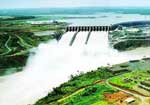Brazil at a Glance
Forecasted to be the 5th largest economy in the next decade, Brazil plays a strategic role in the global economic and geopolitical arena. Currently, the country shows a balanced blend of steady economic growth and environmental sustainability that, combined with the effective wealth distribution programs, create an outstanding climate for business to growth.
Brazil at a glance:
Stable economic growth and sustainability
The solid Brazilian economic basis lead the country to a development cycle, with growth in Gross Domestic Product (GDP), foreign reserves of over US$ 230 billion, a stable financial system and important social gains: reduction in unemployment rate as well as in social inequality, which has dropped 6% since the beginning of the decade.
Anti-cyclical measures taken by the Brazilian government helped the country to minimize impacts of the global financial crisis. In 2010, the Brazilian economy was positive, growing 7.5%, in 2011: 2.7% and is estimated between 4% and 4.5% for 2012.
Macroeconomic and social structure for long-term transformation
From 2003 to 2008, the Brazilian government has kept inflation relatively low, repurchased all sovereign debt originated in the 1990s, improved risk profile of its government bonds and substantially increased the level of foreign reserves - today Brazil is the fourth largest owner of obligations of the U.S. Treasury.
The macroeconomic policies adopted in Brazil, in recent years, have been quite effective against the severe global financial crisis that began in 2008. The greatest freedom in external accounts enabled also the Brazilian government to implement a set of anti-cyclical fiscal and monetary measures, to reduce the negative impact of the global crisis on Brazilian economic activity, to increase the population’s income and amplified the social inclusion program. For the first time since the 1970s, the Brazilian economy has proved to be more resistant than the developed and developing countries ones.
With solid basis and a strong market, Brazil was able to successfully promote a number of measures against the crisis. On one hand, it adopted an expansionary monetary policy, on the other, it introduced a proactive fiscal policy. The sum of these two actions injected money into the economy by stimulating consumption, keeping jobs and increasing the business dynamics.
Strong domestic market
With a 192 million people, Brazil has a large and fast growing consumer market. Over the past five years, more than 24 million Brazilians moved out of poverty and another 27 million have been incorporated into classes A, B and C. The average income of the Brazilian population has been increasing since 2004, at the same time as inequality in income distribution has been decreasing (6% since 2001). These data reflect successful public policies on income distribution and improvement of employment rates in recent years.
The power of such an expanding domestic market was essential to sustain the economic growth of Brazil, even in the most severe phase of the global financial crisis.
Diversified population
The culture of Brazil presents a very diverse nature reflecting an ethnic and cultural mixing occurred in the colonial period and involving Native  American indigenous, Portuguese and Africans. In the late 19th and early 20th centuries, Arab, Italian, German, Spanish and Japanese immigrants settled in Brazil and created a rich multicultural and multiethnic society. American indigenous, Portuguese and Africans. In the late 19th and early 20th centuries, Arab, Italian, German, Spanish and Japanese immigrants settled in Brazil and created a rich multicultural and multiethnic society.
This diversity shaped an ethnic, cultural, religious and social tolerant and open mind society that easily welcome different traditions and incorporate new habits and working methods. The immigration from neighboring countries such as Argentina, Uruguay, Chile and Bolivia, also contributed to the diversification of customs, habits and beliefs, however, all the immigrants adopted the same national language, in all regions of the vast Brazilian territory of 8.5 million km2. Portuguese is, today, the fifth most spoken language, and the third between the Western ones, after English and Spanish.
This fascinating mix of races and its many facets is reflected in the national food, way of life, music, crafts, architecture, festivals and artistic productions. The country has 17 cultural and natural World Heritage listed by UNESCO.
Open market
Another quality of Brazil is the large amount of natural resources available, such as minerals and agricultural products. Over 300 million hectares of agricultural land in privileged geographic conditions are important to place Brazil as a key player in the international market.
Brazil is the largest economy in South America, with a Gross Domestic Product (GDP) of around 50% of the regional economy. The country has one of the world’s largest commercial aircraft manufacturers, modern telecommunications and cutting-edge banking systems, the largest and most diversified industrial park in Latin America and the world’s eighth largest market for IT outsourcing.
In addition to being the world’s largest producer of coffee, oranges and sugar-cane, Brazil has large reserves of iron ore, bauxite, manganese, tin and gold, and is among the world’s top producers of consumer goods, foodstuffs, soft drinks, steel, automobiles, shoes, paper and electric energy generation.
Brazil has attracted a growing number of foreign investors, motivated by great business opportunities in several sectors such as: infrastructure, real estate, IT, biotechnology, agribusiness, energy, mineral resources, manufacturing and services.
Country of renewable, abundant and clean energy
 Brazilian energy is abundant and diverse. The country is self-sufficient in oil and has several sources of clean energy such as hydro energy, wind power and ethanol. Today, 46% of energy production in Brazil is based on renewable sources. Brazilian energy is abundant and diverse. The country is self-sufficient in oil and has several sources of clean energy such as hydro energy, wind power and ethanol. Today, 46% of energy production in Brazil is based on renewable sources.
About 95% of the Brazilian population has access to electricity. There are over 61.5 million operating lines that reach 99% of Brazilian municipalities. Out of this total, 85% are residential customers and 15% are commercial or industrial customers.
Most of the Brazilian electric power comes from hydroelectricity (76%). With 260 GW, Brazil has the largest potential for hydropower generation in the world. From this total, only 30% (77 GW) are being generated by existing plants in the country. There is still a potential of 126 GW to be exploited.
The industrial sector uses 46.7% of the electricity consumed in Brazil, followed by residential (22.1%), business (14.2%), public (8.2%), agriculture (4.3%) energy (4.2%) and transport (0.4%) sectors.
Democratic and institutional stability
Having received US$ 45 billion in 2008, Brazil is one of the leading destinations of the Foreign Direct Investments. Foreign investors have security and legal permission to send profits to their home countries. Additionally, Brazil has double taxation agreements with several countries.
Since 2008, Brazil is classified as investment grade by Standard & Poor's, Moody's and Fitch rating agencies.
Visit Brazil, you are always welcome !
(Partial source: Apex-Brasil)
|